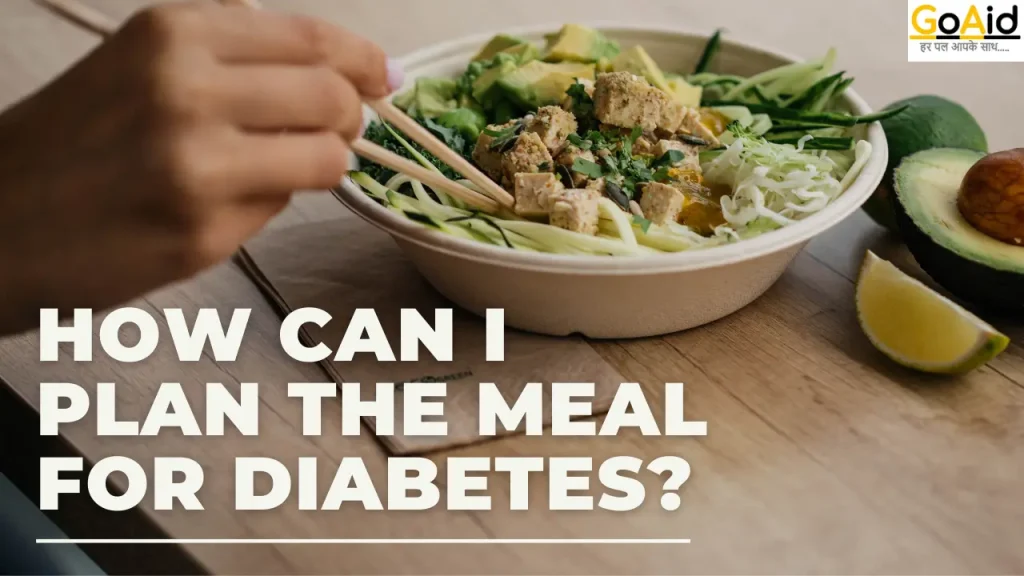In India, millions of people are suffering from Diabetes. When it comes to preventing Diabetes, professionals always suggest controlling the diet and adding some more nutrients to the food we are having. This is why knowing about the food that can help us to control Diabetes is crucial for everyone to know.
This is why, about the Diabetes food, we have added all the details related to it. We have started the blog with basic details of Diabetes and added all the food, Diabetes-friendly food, the 10 best foods for Diabetes control, healthy snacks for Diabetes, Diabetes superfoods, low-carb foods, fruits for Diabetes, protein sources for Diabetes patients, whole grain, anti-diabetic food & also the sugar substitute for the Diabetes. If you are looking to get information about all of them, then read our blog to the very end.
So, letŌĆÖs start-
What is Diabetes?
Diabetes is a chronic condition that occurs when the body either cannot produce enough insulin or cannot effectively use the insulin it produces. Insulin is a hormone that regulates blood sugar levels. There are two main types: Type 1 Diabetes, where the body fails to produce insulin, and Type 2 Diabetes, where the body becomes resistant to insulin or doesn’t produce enough.
High blood sugar levels over time can lead to serious health complications, including heart disease, kidney failure, and nerve damage. Managing Diabetes involves lifestyle changes, such as a healthy diet, regular exercise, and medication when necessary.
Read More Information: What is Diabetes? ŌĆō Top-10 Tips to Prevent Diabetes ŌĆō Complete Guide
How to Control Diabetes? ŌĆō Tips to Control the Diabetes

Managing diabetes effectively requires a combination of lifestyle changes, regular monitoring, and medical intervention. Here are some tips to control diabetes:
1. Maintain a Healthy Diet
- Choose Low-Glycemic Foods: Opt for foods with a low glycemic index (GI) such as whole grains, legumes, vegetables, and fruits. These foods have a slower impact on blood sugar levels.
- Balance Carbohydrates: Spread carbohydrate intake throughout the day to avoid blood sugar spikes. Focus on complex carbs rather than simple sugars.
- Include Fiber-Rich Foods: Fiber helps regulate blood sugar levels. Include plenty of vegetables, fruits, whole grains, and legumes in your diet.
- Limit Processed Foods: Reduce consumption of processed and refined foods that are high in sugar and unhealthy fats.
2. Regular Physical Activity
- Exercise Regularly: Aim for at least 150 minutes of moderate aerobic activity or 75 minutes of vigorous activity each week. Activities like walking, cycling, and swimming are beneficial.
- Strength Training: Include strength training exercises at least twice a week to improve insulin sensitivity and blood sugar control.
3. Monitor Blood Sugar Levels
- Regular Testing: Monitor your blood sugar levels regularly as advised by your healthcare provider. Keeping track of your levels helps you understand how your lifestyle choices affect your diabetes.
- Use Technology: Utilize continuous glucose monitors (CGMs) or blood glucose meters to keep a close eye on your blood sugar.
4. Medication and Insulin Therapy
- Follow Prescriptions: Take medications or insulin as prescribed by your doctor. Do not skip doses, and follow the recommended timing and dosage.
- Consult Your Doctor: Regularly consult with your healthcare provider to adjust medications as needed based on your blood sugar levels and overall health.
5. Healthy Weight Management
- Achieve a Healthy Weight: If you are overweight, losing even a small amount of weight can significantly improve blood sugar control.
- Sustainable Weight Loss: Aim for gradual, sustainable weight loss through a balanced diet and regular exercise.
6. Stay Hydrated
- Drink Plenty of Water: Staying hydrated helps maintain blood sugar levels. Water is the best choice; avoid sugary drinks and limit alcohol consumption.
7. Manage Stress
- Stress Reduction Techniques: Practice stress-reducing activities such as yoga, meditation, deep breathing exercises, or hobbies that you enjoy.
- Adequate Sleep: Ensure you get enough sleep, as poor sleep can negatively affect blood sugar control.
8. Regular Medical Check-Ups
- Routine Check-Ups: Regular visits to your healthcare provider for check-ups and tests to monitor your overall health and manage any complications early.
- Eye and Foot Care: Pay special attention to your eye and foot health, as diabetes can lead to complications in these areas.
9. Education and Support
- Stay Informed: Educate yourself about diabetes and its management. Stay updated on new research and treatments.
- Support Groups: Join diabetes support groups to share experiences, gain insights, and receive emotional support from others facing similar challenges.
Read More: What are the symptoms of Diabetes?
How can I Plan the Meal for Diabetes?

Planning meals for diabetes involves balancing carbohydrates, proteins, and fats to manage blood sugar levels effectively. HereŌĆÖs a step-by-step guide to help you create diabetes-friendly meals:
1. Understand Carbohydrate Counting
- Learn Carbohydrate Basics: Understand that carbohydrates have the most significant impact on blood sugar levels. Foods like bread, rice, fruits, and sweets are high in carbs.
- Set Carb Limits: Work with your healthcare provider to determine your daily carbohydrate intake. A common goal is 45-60 grams of carbs per meal, but this can vary.
2. Choose Low-Glycemic Index Foods
- Opt for Low-GI Foods: Select foods that have a low glycemic index, as they cause a slower rise in blood sugar levels. Examples include whole grains, non-starchy vegetables, legumes, and some fruits like berries and apples.
3. Balance Your Plate
- Use the Plate Method: Divide your plate into sections to control portions:
- Half the plate with non-starchy vegetables (spinach, broccoli, carrots).
- One-quarter with lean protein (chicken, fish, tofu).
- One-quarter with whole grains or starchy vegetables (brown rice, quinoa, sweet potatoes).
4. Incorporate Fiber-Rich Foods
- Add Fiber: Include plenty of fiber-rich foods to help manage blood sugar. Fiber slows down digestion and sugar absorption. Good sources include vegetables, fruits, whole grains, and legumes.
5. Include Healthy Fats
- Choose Healthy Fats: Incorporate unsaturated fats such as avocados, nuts, seeds, olive oil, and fatty fish. These fats can help improve cholesterol levels and reduce inflammation.
6. Plan Regular Meals and Snacks
- Consistent Eating Schedule: Eat at regular intervals to avoid blood sugar spikes and dips. Plan for three balanced meals and 1-2 healthy snacks daily.
- Healthy Snacks: Choose snacks like Greek yogurt, a handful of nuts, or sliced vegetables with hummus.
7. Stay Hydrated
- Drink Water: Aim to drink plenty of water throughout the day. Avoid sugary drinks and limit fruit juices. Herbal teas and black coffee are also good choices.
8. Monitor Portion Sizes
- Control Portions: Be mindful of portion sizes, especially for high-carb foods. Use measuring cups, a food scale, or visual cues to maintain appropriate portions.
9. Plan Ahead
- Meal Prep: Prepare meals in advance to ensure you have healthy options readily available. Batch cooking and storing meals in portion-sized containers can save time and reduce the temptation to eat unhealthy foods.
- Grocery Shopping: Make a shopping list based on your meal plan to avoid impulse purchases and ensure you have all the ingredients for balanced meals.
10. Track and Adjust
- Monitor Blood Sugar: Keep track of your blood sugar levels to see how different foods and meal timing affect you. Adjust your meal plan as needed in consultation with your healthcare provider.
- Food Diary: Consider keeping a food diary to note what you eat and how it affects your blood sugar. This can help identify patterns and areas for improvement.
Also Read: How to cure diabetes permanently?
List of Diabetes superfoods
We have listed the List of top 10 Diabetes Superfoods. These superfoods are rich in essential nutrients and have specific benefits that help manage diabetes by stabilizing blood sugar levels, reducing inflammation, and promoting overall health.
| SN | Diabetes Super Foods | Specifications / Nutrients | Benefits |
| 1 | Leafy Greens | Vitamins A, C, K, folate, fiber | Lowers inflammation, supports heart health |
| 2 | Berries | Fiber, antioxidants, vitamins C and K | Reduces blood sugar spikes, combats oxidative stress |
| 3 | Fatty Fish | Omega-3 fatty acids, protein, vitamin D | Reduces inflammation, improves insulin sensitivity |
| 4 | Nuts | Healthy fats, protein, fiber, magnesium | Improves heart health, helps blood sugar control |
| 5 | Whole Grains | Fiber, B vitamins, iron, magnesium | Stabilizes blood sugar, promotes fullness |
| 6 | Beans | Fiber, protein, iron, folate | Manages blood sugar, provides lasting energy |
| 7 | Greek Yogurt | Protein, calcium, probiotics | Supports gut health, stabilizes blood sugar |
| 8 | Chia Seeds | Fiber, omega-3 fatty acids, antioxidants | Helps manage blood sugar, supports heart health |
| 9 | Avocados | Healthy fats, fiber, potassium, vitamins E and C | Controls blood sugar, improves heart health |
| 10 | Sweet Potatoes | Fiber, vitamins A and C, potassium | Provides stable energy, supports vision and immune function |
20 Best Vegetables for Diabetes
We have enlisted the list of 20 best Vegetables for Diabetic Patients. If you have diabetes, then you can consume healthy vegetables. These vegetables are rich in essential nutrients and offer various health benefits, including stabilizing blood sugar levels, reducing inflammation, and promoting overall health. Including a variety of these vegetables in your diet can help manage diabetes effectively.
| SN | Best Vegetables for Diabetes | Specifications / Nutrients | Benefits |
| 1 | Spinach | Vitamins A, C, K, folate, fiber | Lowers inflammation, supports heart health |
| 2 | Kale | Vitamins A, C, K, calcium, antioxidants | Reduces oxidative stress, improves bone health |
| 3 | Broccoli | Vitamins C, K, fiber, sulforaphane | Lowers blood sugar, supports detoxification |
| 4 | Cauliflower | Vitamins C, K, fiber, folate | Manages blood sugar, supports digestion |
| 5 | Brussels Sprouts | Vitamins C, K, fiber, antioxidants | Reduces inflammation, supports heart health |
| 6 | Zucchini | Vitamins A, C, fiber, potassium | Lowers blood sugar, aids in hydration |
| 7 | Bell Peppers | Vitamins A, C, K, fiber, antioxidants | Reduces inflammation, boosts immune function |
| 8 | Carrots | Vitamins A, K, fiber, beta-carotene | Supports vision health, stabilizes blood sugar |
| 9 | Tomatoes | Vitamins C, K, potassium, lycopene | Reduces inflammation, supports heart health |
| 10 | Asparagus | Vitamins A, C, K, fiber, folate | Supports digestive health, reduces inflammation |
| 11 | Green Beans | Vitamins C, K, fiber, manganese | Supports heart health, manages blood sugar |
| 12 | Eggplant | Fiber, antioxidants, manganese | Supports blood sugar control, reduces inflammation |
| 13 | Mushrooms | Vitamins D, B, selenium, antioxidants | Supports immune function, reduces inflammation |
| 14 | Cucumbers | Vitamins K, C, fiber, hydration | Lowers blood sugar, aids in hydration |
| 15 | Celery | Vitamins K, C, fiber, potassium | Supports digestion, lowers blood pressure |
| 16 | Cabbage | Vitamins C, K, fiber, folate | Reduces inflammation, supports digestion |
| 17 | Artichokes | Fiber, vitamins C, K, folate | Supports digestion, manages blood sugar |
| 18 | Onions | Vitamins C, B6, folate, antioxidants | Supports heart health, lowers blood sugar |
| 19 | Garlic | Vitamins C, B6, manganese, allicin | Supports heart health, reduces blood sugar |
| 20 | Radishes | Vitamins C, fiber, potassium | Supports digestion, helps manage blood sugar |
20 Best Fruits for Diabetic Patients
We have enlisted the 20 Best Fruits for Diabetic Patients. These fruits are nutrient-dense and offer various health benefits, such as stabilizing blood sugar levels, reducing inflammation, and providing essential vitamins and minerals. Including a variety of these fruits in your diet can help manage diabetes effectively.
| SN | Best Fruits for Diabetic Patients | Specifications / Nutrients | Benefits |
| 1 | Berries (Blueberries, Strawberries, Raspberries) | Fiber, antioxidants, vitamins C and K | Reduces blood sugar spikes, combats oxidative stress |
| 2 | Apples | Fiber, vitamin C, antioxidants | Supports heart health, promotes satiety |
| 3 | Oranges | Fiber, vitamin C, folate | A low glycemic index boosts immune function |
| 4 | Pears | Fiber, vitamins C and K, potassium | Regulates blood sugar, supports heart health |
| 5 | Cherries | Fiber, vitamin C, antioxidants | Reduces inflammation, manages blood sugar |
| 6 | Plums | Fiber, vitamins C and K, antioxidants | Supports digestion, regulates blood sugar |
| 7 | Kiwi | Fiber, vitamin C, antioxidants | Supports immune function, promotes digestion |
| 8 | Grapefruit | Fiber, vitamin C, antioxidants | Low glycemic index, aids in weight management |
| 9 | Peaches | Fiber, vitamins A and C, potassium | Supports skin health, manages blood sugar |
| 10 | Avocados | Healthy fats, fiber, vitamins E and C, potassium | Controls blood sugar, improves heart health |
| 11 | Apricots | Fiber, vitamins A and C, potassium | Supports eye health, regulates blood sugar |
| 12 | Papayas | Fiber, vitamins A and C, folate | Supports digestion, boosts immune function |
| 13 | Blackberries | Fiber, vitamin C, antioxidants | Lowers blood sugar, supports heart health |
| 14 | Guavas | Fiber, vitamins A and C, folate | Supports immune function, regulates blood sugar |
| 15 | Pomegranates | Fiber, vitamins C and K, antioxidants | Supports heart health, reduces inflammation |
| 16 | Cantaloupe | Fiber, vitamins A and C, potassium | Supports hydration, regulates blood sugar |
| 17 | Starfruit (Carambola) | Fiber, vitamin C, antioxidants | A low glycemic index supports immune function |
| 18 | Dragon Fruit | Fiber, vitamins C and B, antioxidants | Supports gut health, regulates blood sugar |
| 19 | Mulberries | Fiber, vitamins C and K, iron, antioxidants | Supports heart health, manages blood sugar |
| 20 | Figs | Fiber, vitamins A and K, potassium | Supports digestive health, regulates blood sugar |
Best Diet for Diabetes Patients
We have enlisted and highlighted all the good and preferred foods for Diabetic Patients below. Hope you love to read what you can eat in Diabetics
10 Best Foods for Diabetes Control
These are the top 10 Best Food for Diabetes Control:
1. Leafy Greens
- Examples: Spinach, kale, Swiss chard
- Benefits: Low in calories and carbohydrates, high in vitamins and minerals like vitamin C, which can help reduce inflammation and support heart health.
2. Berries
- Examples: Blueberries, strawberries, raspberries
- Benefits: High in fiber and antioxidants, which can help reduce oxidative stress and inflammation. They have a lower glycemic index than other fruits.
3. Fatty Fish
- Examples: Salmon, mackerel, sardines
- Benefits: Rich in omega-3 fatty acids, which can reduce inflammation and improve heart health. They are also a great source of protein.
4. Whole Grains
- Examples: Quinoa, brown rice, oats
- Benefits: High in fiber and nutrients, which can help control blood sugar levels and improve insulin sensitivity. They also promote a feeling of fullness.
5. Nuts
- Examples: Almonds, walnuts, pistachios
- Benefits: Low in carbs but high in healthy fats, fiber, and protein. They can help reduce blood sugar spikes and improve heart health.
6. Greek Yogurt
- Benefits: High in protein and probiotics, which can help manage blood sugar levels and promote gut health. It has fewer carbs compared to regular yogurt.
7. Chia Seeds
- Benefits: Extremely high in fiber, which can help manage blood sugar levels. They also provide a good source of omega-3 fatty acids and antioxidants.
8. Beans
- Examples: Black beans, kidney beans, lentils
- Benefits: High in fiber and protein, which can help stabilize blood sugar levels and keep you feeling full longer. They also provide essential vitamins and minerals.
9. Avocados
- Benefits: High in healthy monounsaturated fats and fiber, which can improve blood sugar control and reduce the risk of heart disease. They also have a very low glycemic index.
10. Citrus Fruits
- Examples: Oranges, lemons, grapefruits
- Benefits: High in fiber and vitamin C, which can help manage blood sugar levels and support immune function. They have a moderate glycemic index and are low in carbs compared to other fruits.
List of Anti-diabetic foods
We have added a comprehensive list of 20 anti-diabetic foods. This table provides a detailed overview of various anti-diabetic foods, their specifications, benefits, and descriptions, helping diabetic patients make informed dietary choices.
| SN | Anti-diabetes Food | Specification | Benefits | Description |
| 1 | Broccoli | High in fiber and antioxidants | Helps lower blood sugar levels | Broccoli is rich in vitamins A, C, and K, and contains a compound called sulforaphane that has anti-diabetic properties. |
| 2 | Spinach | Low in carbohydrates and calories | Improves insulin sensitivity | Spinach is packed with vitamins and minerals, including magnesium, which is beneficial for blood sugar control. |
| 3 | Berries | High in fiber and antioxidants | Reduces blood sugar spikes | Berries such as strawberries, blueberries, and raspberries are low in sugar and high in fiber and antioxidants. |
| 4 | Chia Seeds | High in fiber and omega-3 fatty acids | Stabilizes blood sugar levels | Chia seeds absorb water and form a gel-like consistency, slowing the absorption of sugar into the bloodstream. |
| 5 | Avocado | Rich in healthy fats and fiber | Improves insulin sensitivity | Avocados are low in carbohydrates and have been shown to lower blood sugar levels and reduce inflammation. |
| 6 | Flaxseeds | High in fiber and omega-3 fatty acids | Supports heart health and blood sugar control | Flaxseeds help improve blood sugar levels and reduce the risk of cardiovascular disease. |
| 7 | Cinnamon | Contains antioxidants and anti-inflammatory properties | Lower fasting blood sugar levels | Cinnamon has been shown to improve insulin sensitivity and lower blood sugar levels. |
| 8 | Nuts | High in healthy fats and protein | Helps regulate blood sugar levels | Nuts like almonds, walnuts, and pistachios are low in carbohydrates and can improve blood sugar control. |
| 9 | Sweet Potatoes | High in fiber and vitamins | Slows down sugar absorption | Sweet potatoes have a lower glycemic index than regular potatoes and are rich in fiber and antioxidants. |
| 10 | Garlic | Contains allicin and antioxidants | Reduces blood sugar levels | Garlic has been shown to improve blood sugar control and reduce the risk of cardiovascular disease. |
| 11 | Beans | High in fiber and protein | Helps stabilize blood sugar levels | Beans such as black beans, lentils, and chickpeas are low in glycemic index and rich in nutrients. |
| 12 | Green Tea | Contains antioxidants and polyphenols | Improves insulin sensitivity | Green tea has been shown to lower blood sugar levels and increase insulin sensitivity. |
| 13 | Turmeric | Contains curcumin | Anti-inflammatory and blood sugar-lowering properties | Turmeric’s active ingredient, curcumin, has powerful anti-diabetic properties. |
| 14 | Tomatoes | Low in carbohydrates and high in vitamins | Supports heart health and blood sugar control | Tomatoes are rich in vitamins C and E and are beneficial for overall health. |
| 15 | Citrus Fruits | High in vitamin C and fiber | Helps regulate blood sugar levels | Citrus fruits like oranges, lemons, and grapefruits are low in glycemic index and high in fiber. |
| 16 | Apple Cider Vinegar | Contains acetic acid | Improves insulin sensitivity | Apple cider vinegar has been shown to lower blood sugar levels and improve insulin function. |
| 17 | Quinoa | High in protein and fiber | Helps stabilize blood sugar levels | Quinoa is a complete protein and has a low glycemic index, making it a great grain for diabetics. |
| 18 | Greek Yogurt | High in protein and probiotics | Supports gut health and blood sugar control | Greek yogurt is low in sugar and high in protein, making it a suitable option for managing blood sugar. |
| 19 | Bell Peppers | Low in carbohydrates and high in vitamins | Supports overall health | Bell peppers are rich in vitamins A and C and are low in carbohydrates, making them ideal for diabetics. |
| 20 | Whole Grains | High in fiber and nutrients | Helps manage blood sugar levels | Whole grains like oats, barley, and brown rice are rich in fiber and have a lower glycemic index. |
Sugar substitutes for diabetics
These are the best sugar substitutes for the Diabetics Patients:
| SN | Sugar Substitute | Description | Benefits | Usage |
| 1 | Stevia | Natural sweetener from Stevia rebaudiana plant | Zero calories do not raise blood sugar levels | Beverages, baking, cooking |
| 2 | Sucralose (Splenda) | Artificial sweeteners made from sugar | Zero calories, no impact on blood glucose levels | Beverages, desserts, baking |
| 3 | Aspartame | Artificial sweetener made from aspartic acid and phenylalanine | Very low in calories, does not affect blood sugar levels | Beverages, desserts, chewing gum |
| 4 | Monk Fruit Extract | Natural sweetener from monk fruit | Zero calories do not affect blood glucose levels | Beverages, desserts, baking |
| 5 | Erythritol | Sugar alcohol naturally found in fruits | Low in calories, does not spike blood sugar levels | Baking, cooking, tabletop |
| 6 | Xylitol | Sugar alcohol found in fruits and vegetables | A low glycemic index does not cause blood glucose spikes | Chewing gum, candies, dental products |
Healthy Snacks for Diabetes
If you are feeling hungry and want some healthy snacks, then you can try the:
1. Greek Yogurt with Berries – Best Snack for Diabetes Patients
Why it is good for diabetes patients?
Greek yogurt is high in protein, which helps control hunger and stabilize blood sugar levels. Berries add fiber and antioxidants without causing a significant blood sugar spike.
Benefits
- High in protein
- Rich in antioxidants
- Contains probiotics for gut health
- Low glycemic index
Read More: What is the cause of Diabetes?
2. Apple Slices with Peanut Butter – Best Snack for Diabetes Patients
Why it is good for diabetes patients?
The combination of fiber from the apple and healthy fats from the peanut butter helps slow down the absorption of sugars and provides lasting energy.
Benefits
- High in fiber
- Contains healthy fats
- Helps control hunger
- Satisfies sweet and savory cravings
3. Carrot Sticks with Hummus – Best Snack for Diabetes Patients
Why it is good for diabetes patients?
Carrots are low in calories and high in fiber, while hummus provides protein and healthy fats, making it a balanced and satisfying snack.
Benefits
- Low in calories
- High in fiber
- Provides protein and healthy fats
- Promotes satiety
4. Almonds – Best Snack for Diabetes Patients
Why it is good for diabetes patients?
Almonds are low in carbohydrates but high in healthy fats, fiber, and protein, which help control blood sugar levels and keep you full longer.
Benefits
- Low in carbs
- High in healthy fats
- Rich in fiber and protein
- Supports heart health
5. Chia Seed Pudding – Best Snack for Diabetes Patients
Why it is good for diabetes patients?
Chia seeds are high in fiber and omega-3 fatty acids. When made into pudding, they provide a nutrient-dense, low-carb snack that helps stabilize blood sugar levels.
Benefits
- Extremely high in fiber
- Contains omega-3 fatty acids
- Low in carbohydrates
- Helps manage blood sugar levels
6. Hard-Boiled Eggs – Best Snack for Diabetes Patients
Why it is good for diabetes patients?
Hard-boiled eggs are a convenient and protein-rich snack that can help stabilize blood sugar levels and keep you feeling full.
Benefits
- High in protein
- Low in carbohydrates
- Easy to prepare and carry
- Promotes satiety
7. Cottage Cheese with Cucumber Slices – Best Snack for Diabetes Patients
Why it is good for diabetes patients?
Cottage cheese is high in protein and low in carbohydrates, while cucumbers add fiber and hydration, making this a refreshing and balanced snack.
Benefits
- High in protein
- Low in carbohydrates
- Contains fiber and hydration
- Supports weight management
8. Edamame – Best Snack for Diabetes Patients
Why it is good for diabetes patients?
Edamame is rich in protein, fiber, and healthy fats, which help keep blood sugar levels stable and provide lasting energy.
Benefits
- High in protein
- Rich in fiber
- Contains healthy fats
- Helps manage blood sugar levels
9. Avocado Slices with Lemon – Best Snack for Diabetes Patients
Why it is good for diabetes patients?
Avocado is high in healthy monounsaturated fats and fiber, which help control blood sugar levels. A squeeze of lemon adds flavor and vitamin C.
Benefits
- High in healthy fats
- Rich in fiber
- Low glycemic index
- Supports heart health
10. Celery Sticks with Almond Butter – Best Snack for Diabetes Patients
Why it is good for diabetes patients?
Celery is low in calories and carbohydrates, while almond butter provides healthy fats and protein, making this a crunchy and satisfying snack.
Benefits
- Low in calories and carbs
- High in healthy fats
- Provides protein
- Promotes satiety
Also Read: Types of Diabetes
Low-Carb Foods for Diabetes

Incorporating low-carb foods into your diet can help manage blood sugar levels more effectively. Here are some of the best low-carb foods for diabetes:
1. Leafy Greens – Nutrient-Dense and Low in Carbs
- Examples: Spinach, kale, Swiss chard, lettuce
- Benefits: Extremely low in carbohydrates and calories, but high in vitamins, minerals, and antioxidants. They help reduce inflammation and support overall health.
- Nutritional Highlights: Rich in vitamin C, vitamin K, folate, and fiber.
2. Cruciferous Vegetables – Low Carb and High in Fiber
- Examples: Broccoli, cauliflower, Brussels sprouts, cabbage
- Benefits: Low in carbs and high in fiber, which helps slow the absorption of sugar and improve digestion. They also contain antioxidants and cancer-fighting compounds.
- Nutritional Highlights: High in vitamin C, vitamin K, and folate.
3. Berries – Low Sugar Fruits
- Examples: Strawberries, blueberries, raspberries, blackberries
- Benefits: Berries are lower in sugar compared to other fruits and high in fiber and antioxidants. They help reduce blood sugar spikes and combat oxidative stress.
- Nutritional Highlights: High in fiber, vitamin C, and various antioxidants.
4. Nuts and Seeds – Healthy Fats and Protein
- Examples: Almonds, walnuts, flaxseeds, chia seeds
- Benefits: Nuts and seeds are low in carbs but rich in healthy fats, protein, and fiber. They can improve heart health and help with blood sugar control.
- Nutritional Highlights: High in omega-3 fatty acids, magnesium, and fiber.
5. Fatty Fish – Low Carb Protein Source
- Examples: Salmon, mackerel, sardines, trout
- Benefits: Fatty fish are low in carbs and an excellent source of omega-3 fatty acids, which can reduce inflammation and improve insulin sensitivity.
- Nutritional Highlights: Rich in omega-3 fatty acids, protein, and vitamin D.
6. Eggs – Versatile and Low Carb
- Benefits: Eggs are low in carbohydrates and high in protein, making them a perfect food for blood sugar control. They also contain essential vitamins and minerals.
- Nutritional Highlights: High in protein, vitamin B12, and selenium.
7. Greek Yogurt – Low-Carb Dairy Option
- Benefits: Greek yogurt is lower in carbs than regular yogurt and higher in protein. It also contains probiotics, which can aid in gut health.
- Nutritional Highlights: High in protein, calcium, and probiotics.
8. Avocados – Healthy Fats and Fiber
- Benefits: Avocados are low in carbs and high in healthy monounsaturated fats and fiber, which help manage blood sugar levels and promote heart health.
- Nutritional Highlights: Rich in healthy fats, fiber, potassium, and vitamins E and C.
9. Zucchini – Low Carb Vegetable
- Benefits: Zucchini is low in carbs and calories but high in vitamins and minerals. It can be used as a substitute for higher-carb foods like pasta.
- Nutritional Highlights: High in vitamin C, vitamin A, and potassium.
10. Cheese – Low-Carb Dairy
- Examples: Cheddar, mozzarella, feta, goat cheese
- Benefits: Cheese is low in carbs and a good source of protein and calcium. It can be a satisfying and blood sugar-friendly addition to meals and snacks.
- Nutritional Highlights: High in protein, calcium, and various vitamins depending on the type of cheese.
Whole grains for Diabetes control
These are the top 10 Whole Grains that can be consumed by Diabetic Patients for Diabetes Control:
1. Quinoa – Best Whole Grain for Diabetes Patients
- Quinoa: Quinoa is a complete protein and gluten-free grain rich in fiber, magnesium, and iron. It has a low glycemic index, aiding in stable blood sugar levels and improved insulin sensitivity.
- Specifications and Nutrients:
- High in protein and fiber
- Rich in magnesium and iron
- Gluten-free
- Benefits:
- Helps stabilize blood sugar levels
- Supports heart health
- Provides sustained energy
2. Oats – Best Whole Grain for Diabetes Patients
- Oats: Oats are high in soluble fiber, particularly beta-glucan, which slows digestion and helps manage blood sugar levels. They are also rich in vitamins, minerals, and antioxidants.
- Specifications and Nutrients:
- Rich in beta-glucan fiber
- High in vitamins and minerals
- Source of antioxidants
- Benefits:
- Improves insulin sensitivity
- Supports digestive health
- Reduces risk of heart disease
3. Brown Rice – Best Whole Grain for Diabetes Patients
- Brown Rice: Brown rice retains its bran and germ layers, offering fiber, vitamins, and minerals. It has a lower glycemic index compared to white rice, supporting better blood sugar control.
- Specifications and Nutrients:
- Contains fiber, vitamins, and minerals
- Lower glycemic index than white rice
- Benefits:
- Helps regulate blood sugar levels
- Provides sustained energy
- Supports digestive health
Also Read: Importance of Regular Health Check-Ups
4. Barley – Best Whole Grain for Diabetes Patients
- Barley: Barley contains beta-glucan fiber, which helps lower blood sugar levels and improve insulin resistance. It is also rich in vitamins, minerals, and antioxidants.
- Specifications and Nutrients:
- High in beta-glucan fiber
- Rich in vitamins and minerals
- Source of antioxidants
- Benefits:
- Lowers blood sugar levels
- Supports heart health
- Improves digestion
5. Buckwheat – Best Whole Grain for Diabetes Patients
- Buckwheat: Buckwheat is gluten-free and high in fiber and protein. It has a low glycemic index, helping to maintain stable blood sugar levels and support digestive health.
- Specifications and Nutrients:
- High in fiber and protein
- Gluten-free
- Low glycemic index
- Benefits:
- Supports blood sugar control
- Aids in digestion
- Provides lasting energy
6. Whole Wheat – Best Whole Grain for Diabetes Patients
- Whole Wheat: Whole wheat includes the entire grain kernel, making it rich in fiber, vitamins, and minerals. It has a lower glycemic index than refined wheat products.
- Specifications and Nutrients:
- High in fiber
- Rich in vitamins and minerals
- Contains the entire grain kernel
- Benefits:
- Stabilizes blood sugar levels
- Supports digestive health
- Provides sustained energy
7. Millet – Best Whole Grain for Diabetes Patients
- Millet: Millet is a gluten-free grain high in fiber, vitamins, and minerals. It has a low glycemic index, making it suitable for managing blood sugar levels.
- Specifications and Nutrients:
- High in fiber
- Rich in vitamins and minerals
- Gluten-free
- Benefits:
- Helps control blood sugar levels
- Supports digestive health
- Provides sustained energy
8. Farro – Best Whole Grain for Diabetes Patients
- Farro: Farro is an ancient grain high in fiber, protein, and essential nutrients like magnesium and iron. It provides complex carbohydrates for steady energy.
- Specifications and Nutrients:
- High in fiber and protein
- Rich in magnesium and iron
- Benefits:
- Supports blood sugar control
- Provides lasting energy
- Supports heart health
9. Amaranth – Best Whole Grain for Diabetes Patients
- Amaranth: Amaranth is a gluten-free grain rich in protein, fiber, and micronutrients such as calcium and magnesium. It has a low glycemic index, beneficial for blood sugar management.
- Specifications and Nutrients:
- High in protein and fiber
- Rich in calcium and magnesium
- Gluten-free
- Benefits:
- Helps manage blood sugar levels
- Supports bone health
- Provides sustained energy
10. Rye – Best Whole Grain for Diabetes Patients
- Rye: Rye is rich in fiber and has a lower glycemic index compared to wheat. It supports stable blood sugar levels and offers antioxidants and essential vitamins.
- Specifications and Nutrients:
- High in fiber
- Lower glycemic index than wheat
- Contains antioxidants and vitamins
- Benefits:
- Helps control blood sugar levels
- Supports heart health
- Improves digestive health
Also Read: Introduction to the Importance of Health
Protein Sources for diabetics Patients
We have added around 20 sources of protein that can be consumed by a patient with Diabetes. Incorporating these protein sources into a balanced diet can help diabetic patients maintain stable blood sugar levels, support muscle growth and repair, and promote overall health.
1. Chicken Breast – Lean Protein Source
- Description: Skinless chicken breast is a lean source of protein, low in fat and carbohydrates. It is versatile and can be prepared in various healthy ways.
- Specifications and Nutrients:
- High in protein
- Low in fat and carbohydrates
- Rich in vitamins B3 and B6
- Benefits:
- Helps build and repair tissues
- Supports immune function
- Promotes satiety, aiding in weight management
2. Turkey – Low-Fat Protein
- Description: Turkey, especially white meat, is a low-fat, high-protein option that is also rich in essential nutrients.
- Specifications and Nutrients:
- High in protein
- Low in fat
- Contains vitamins B6 and B12, zinc, and selenium
- Benefits:
- Supports muscle growth and repair
- Enhances immune system function
- Helps maintain healthy blood sugar levels
3. Fish – Rich in Omega-3 Fatty Acids
- Description: Fatty fish like salmon, mackerel, and sardines are excellent sources of protein and omega-3 fatty acids, which have numerous health benefits.
- Specifications and Nutrients:
- High in protein
- Rich in omega-3 fatty acids
- Contains vitamins D and B2, calcium, and phosphorus
- Benefits:
- Reduces inflammation
- Improves insulin sensitivity
- Supports heart health
4. Eggs – Versatile and Nutrient-Dense
- Description: Eggs are a versatile and nutrient-dense source of high-quality protein. They can be prepared in many ways and incorporated into various meals.
- Specifications and Nutrients:
- High in protein
- Contains vitamins B12 and D, choline, and selenium
- Benefits:
- Supports muscle repair and growth
- Helps manage blood sugar levels
- Promotes brain health
5. Greek Yogurt – Probiotic-Rich Dairy
- Description: Greek yogurt is a thicker, creamier version of regular yogurt, high in protein and probiotics, which are beneficial for gut health.
- Specifications and Nutrients:
- High in protein
- Contains probiotics, calcium, and vitamins B6 and B12
- Benefits:
- Supports gut health
- Helps maintain stable blood sugar levels
- Provides satiety and aids in weight management
6. Tofu – Plant-Based Protein
- Description: Tofu is made from soybeans and is a great plant-based protein source. It is low in carbohydrates and can be used in a variety of dishes.
- Specifications and Nutrients:
- High in protein
- Low in carbohydrates
- Contains iron, calcium, and magnesium
- Benefits:
- Supports muscle growth and repair
- Helps manage blood sugar levels
- Promotes heart health
7. Lentils – High-Fiber Legume
- Description: Lentils are legumes that are high in protein and fiber, making them a great option for managing blood sugar levels.
- Specifications and Nutrients:
- High in protein and fiber
- Contains iron, folate, and potassium
- Benefits:
- Helps regulate blood sugar levels
- Supports digestive health
- Provides lasting energy
8. Chickpeas – Nutrient-Rich Legume
- Description: Chickpeas, also known as garbanzo beans, are rich in protein, fiber, and various vitamins and minerals.
- Specifications and Nutrients:
- High in protein and fiber
- Contains iron, folate, and manganese
- Benefits:
- Supports blood sugar management
- Promotes digestive health
- Enhances satiety and aids in weight control
9. Cottage Cheese – Low-Fat Dairy
- Description: Cottage cheese is a low-fat dairy product high in protein and calcium, making it a great option for those looking to manage their blood sugar.
- Specifications and Nutrients:
- High in protein
- Low in fat
- Contains calcium and vitamins B12 and A
- Benefits:
- Supports bone health
- Helps manage blood sugar levels
- Promotes muscle growth and repair
Read More: 7 Most Common Diseases in Summer | Symptoms, Causes, Treatment / Cure ŌĆō A Complete Guide
10. Nuts – Healthy Fat and Protein Source
- Description: Nuts like almonds, walnuts, and pistachios are high in protein, healthy fats, and fiber. They are excellent for snacking and adding to meals.
- Specifications and Nutrients:
- High in protein and healthy fats
- Contains fiber, magnesium, and vitamin E
- Benefits:
- Supports heart health
- Helps maintain stable blood sugar levels
- Provides lasting energy and satiety
11. Tempeh – Fermented Soy Product
- Description: Tempeh is a fermented soy product that is high in protein, probiotics, and other essential nutrients. It has a firm texture and nutty flavor.
- Specifications and Nutrients:
- High in protein
- Contains probiotics, iron, and calcium
- Benefits:
- Supports gut health
- Helps regulate blood sugar levels
- Promotes muscle repair and growth
12. Edamame – Whole Soybeans
- Description: Edamame is a whole, immature soybeans that are high in protein, fiber, and various vitamins and minerals. They are often eaten as a snack or added to salads.
- Specifications and Nutrients:
- High in protein and fiber
- Contains vitamins K and C, folate, and iron
- Benefits:
- Supports blood sugar management
- Enhances digestive health
- Provides lasting energy
13. Black Beans – High-Fiber Legume
- Description: Black beans are legumes that are high in protein, fiber, and various vitamins and minerals. They are versatile and can be used in many dishes.
- Specifications and Nutrients:
- High in protein and fiber
- Contains iron, magnesium, and folate
- Benefits:
- Helps regulate blood sugar levels
- Supports heart health
- Provides lasting energy
14. Peanut Butter – Protein-Rich Spread
- Description: Peanut butter is a protein-rich spread that also contains healthy fats and fiber. Opt for natural, unsweetened varieties to avoid added sugars.
- Specifications and Nutrients:
- High in protein and healthy fats
- Contains fiber, magnesium, and vitamin E
- Benefits:
- Supports heart health
- Helps maintain stable blood sugar levels
- Provides lasting energy and satiety
15. Seitan – Wheat Gluten Protein
- Description: Seitan, also known as wheat gluten, is a high-protein meat substitute made from gluten, the main protein in wheat. It is low in fat and carbs.
- Specifications and Nutrients:
- High in protein
- Low in fat and carbohydrates
- Contains iron and selenium
- Benefits:
- Supports muscle growth and repair
- Provides a high-protein meat alternative
- Helps manage blood sugar levels
16. Hemp Seeds – Complete Plant Protein
- Description: Hemp seeds are a complete plant protein source rich in healthy fats, fiber, and various vitamins and minerals. They can be added to smoothies, salads, and yogurt.
- Specifications and Nutrients:
- High in protein and healthy fats
- Contains fiber, magnesium, and omega-3 fatty acids
- Benefits:
- Supports heart health
- Helps maintain stable blood sugar levels
- Promotes satiety and provides lasting energy
17. Pumpkin Seeds – Nutrient-Dense Snack
- Description: Pumpkin seeds are high in protein, healthy fats, and various vitamins and minerals. They make a great snack or can be added to dishes for extra nutrition.
- Specifications and Nutrients:
- High in protein and healthy fats
- Contains magnesium, zinc, and iron
- Benefits:
- Supports heart health
- Helps regulate blood sugar levels
- Provides lasting energy and satiety
18. Sunflower Seeds – Protein-Rich Snack
- Description: Sunflower seeds are a nutrient-dense snack high in protein, healthy fats, and various vitamins and minerals. They can be eaten on their own or added to dishes.
- Specifications and Nutrients:
- High in protein and healthy fats
- Contains fiber, vitamin E, and magnesium
- Benefits:
- Supports heart health
- Helps maintain stable blood sugar levels
- Provides lasting energy and satiety
19. Cheese – Low-Carb Dairy Protein
- Description: Cheese is a low-carb dairy product high in protein and calcium. It can be incorporated into various meals and snacks for added nutrition.
- Specifications and Nutrients:
- High in protein
- Contains calcium and vitamins B12 and A
- Benefits:
- Supports bone health
- Helps regulate blood sugar levels
- Provides lasting energy and satiety
20. Cottage Cheese – Low-Fat Dairy
- Description: Cottage cheese is a low-fat dairy product high in protein and calcium, making it a great option for those looking to manage their blood sugar.
- Specifications and Nutrients:
- High in protein
- Low in fat
- Contains calcium and vitamins B12 and A
- Benefits:
- Supports bone health
- Helps manage blood sugar levels
- Promotes muscle growth and repair
Book Ambulance: GoAid Ambulance Service
Conclusion
In conclusion, In managing diabetes, nutrition plays a crucial role. The 10 best foods for diabetes control include a variety of options rich in fiber, vitamins, and minerals that help stabilize blood sugar levels and support overall health. From leafy greens like spinach and kale to protein sources such as chicken breast and fish rich in omega-3 fatty acids, each food offers unique benefits for diabetes management.
By incorporating these foods into a balanced diet, individuals can better regulate blood sugar, improve insulin sensitivity, and reduce the risk of complications associated with diabetes. We’ve covered comprehensive details on diabetes, including meal planning, healthy snacks, low-carb options, superfoods, vegetables, whole grains, protein sources, anti-diabetic foods, and sugar substitutes.
For further queries or additional information, feel free to leave your questions in the comment box below. Take charge of your health with informed choices tailored to your diabetes management needs.














